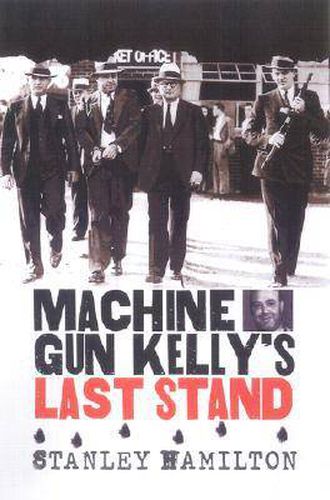Readings Newsletter
Become a Readings Member to make your shopping experience even easier.
Sign in or sign up for free!
You’re not far away from qualifying for FREE standard shipping within Australia
You’ve qualified for FREE standard shipping within Australia
The cart is loading…






This title is printed to order. This book may have been self-published. If so, we cannot guarantee the quality of the content. In the main most books will have gone through the editing process however some may not. We therefore suggest that you be aware of this before ordering this book. If in doubt check either the author or publisher’s details as we are unable to accept any returns unless they are faulty. Please contact us if you have any questions.
Orchestrated to the sounds of getaway cars and machine guns, the abduction of Oklahoma City businessman Charles Urschel in 1933 was a highly publicized crime in an era when gangsters were folk heroes and kidnapping had become a scourge. The criminals’ interstate flight to a desolate hideout in Texas called for federal action, instigating the most intensive manhunt the country had yet seen. It also set in motion a chain of events that would have lasting significance for crime-fighting in America. In an exciting account of that celebrated manhunt, Stanley Hamilton rekindles the spirit of yesterday’s newsreels to chronicle the pursuit and capture of George
Machine Gun
Kelly and his wife, Kathryn. Tapping a wealth of newspaper reports, court transcripts, literary accounts, and recollections of participants, he draws readers into the chase and its aftermath, unraveling what was then considered the most compelling crime mystery of the day. Hamilton sets the stage with an overview of the lawlessness of that era and of Kelly’s formative years, getting under the skin of a hard-boiled criminal to show us what made Kelly tick. He assembles a cast of larger-than-life characters to weave this tale of true crime, one of the largest of whom was the 38-year-old director of the national police force, J. Edgar Hoover. Hoover had revitalized an ineffective agency whose operatives were still not authorized to carry firearms or make arrests, and when the Urschel case broke, it was Hoover who stepped up to coordinate the manhunt. Hamilton takes readers behind the scenes in Hoover’s operation to show how this case was responsible for popularizing the G-man and institutionalizing the FBI, creating the agent-as-hero image that replaced earlier characterizations of blundering foils to glamorous gangsters. This iconic kidnapping case, breathlessly followed by a fascinated public, was so quickly and effectively concluded that it was largely instrumental in bringing about the end of the Gangster Era in America. Machine Gun Kelly’s Last Stand brings that era to life again by providing a fresh look at one of America’s most notorious criminals, vividly recreating the times in which he lived and sharing the stories of the people whose lives he touched.
$9.00 standard shipping within Australia
FREE standard shipping within Australia for orders over $100.00
Express & International shipping calculated at checkout
This title is printed to order. This book may have been self-published. If so, we cannot guarantee the quality of the content. In the main most books will have gone through the editing process however some may not. We therefore suggest that you be aware of this before ordering this book. If in doubt check either the author or publisher’s details as we are unable to accept any returns unless they are faulty. Please contact us if you have any questions.
Orchestrated to the sounds of getaway cars and machine guns, the abduction of Oklahoma City businessman Charles Urschel in 1933 was a highly publicized crime in an era when gangsters were folk heroes and kidnapping had become a scourge. The criminals’ interstate flight to a desolate hideout in Texas called for federal action, instigating the most intensive manhunt the country had yet seen. It also set in motion a chain of events that would have lasting significance for crime-fighting in America. In an exciting account of that celebrated manhunt, Stanley Hamilton rekindles the spirit of yesterday’s newsreels to chronicle the pursuit and capture of George
Machine Gun
Kelly and his wife, Kathryn. Tapping a wealth of newspaper reports, court transcripts, literary accounts, and recollections of participants, he draws readers into the chase and its aftermath, unraveling what was then considered the most compelling crime mystery of the day. Hamilton sets the stage with an overview of the lawlessness of that era and of Kelly’s formative years, getting under the skin of a hard-boiled criminal to show us what made Kelly tick. He assembles a cast of larger-than-life characters to weave this tale of true crime, one of the largest of whom was the 38-year-old director of the national police force, J. Edgar Hoover. Hoover had revitalized an ineffective agency whose operatives were still not authorized to carry firearms or make arrests, and when the Urschel case broke, it was Hoover who stepped up to coordinate the manhunt. Hamilton takes readers behind the scenes in Hoover’s operation to show how this case was responsible for popularizing the G-man and institutionalizing the FBI, creating the agent-as-hero image that replaced earlier characterizations of blundering foils to glamorous gangsters. This iconic kidnapping case, breathlessly followed by a fascinated public, was so quickly and effectively concluded that it was largely instrumental in bringing about the end of the Gangster Era in America. Machine Gun Kelly’s Last Stand brings that era to life again by providing a fresh look at one of America’s most notorious criminals, vividly recreating the times in which he lived and sharing the stories of the people whose lives he touched.